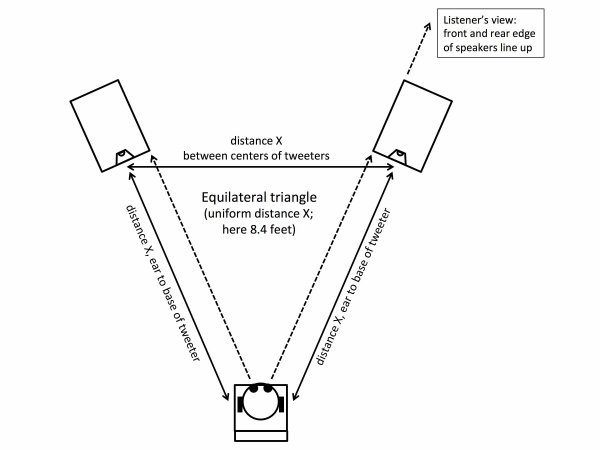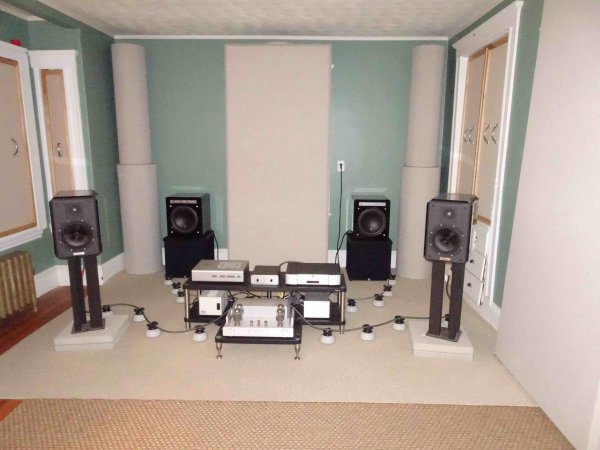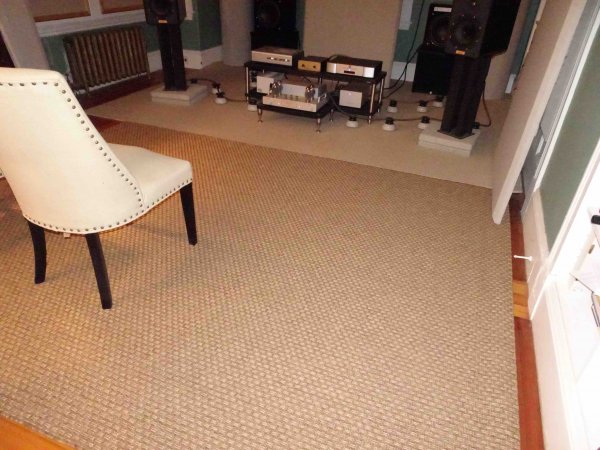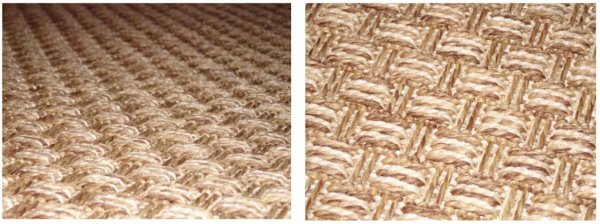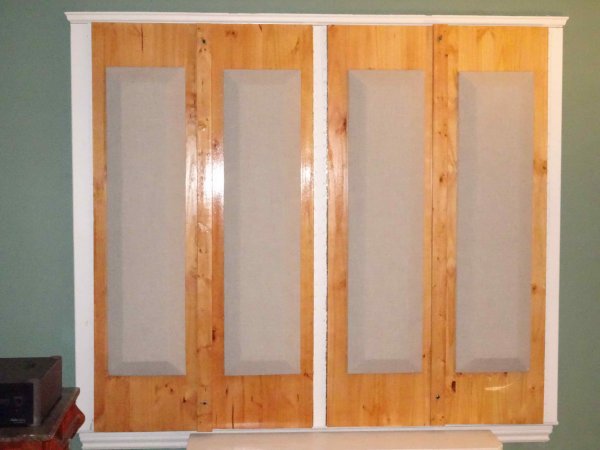Acoustic changes to my room: great additional improvements
Recently I reported on major sound improvements with changes in speaker positioning. Yet despite all the improvements, some things still did not seem quite right. The sound had become much cleaner, but it still did not have the lack of distortion that I heard in friend's systems. I had been blaming the speakers for this, but at some point I thought perhaps something else was going on, especially since the new speaker set-up had removed some distortions that might also in part have been room-related.
In this context, I also felt that the sound had become slightly more 'stingy' again after I had removed a second 5 x 7 ft rug, which I had temporarily supplemented my primary 5 x 7 ft rug with in the listening area (used apart from the 9 x 12 ft rug between speakers and the front wall). I had positioned the two rugs in such a way that they formed one 7 x 10 ft surface; both rugs were made of the same material of natural fiber. Yet I had removed that second rug because the acoustics felt too dead with it, even though high frequencies from the system were still good. Usually the acoustics did not bother me, but it felt uncomfortable especially when my ears were tired at night. It felt as if my ears were clogging from pressure by the more acoustically dead environment. Thankfully, Peter A. also had made helpful remarks regarding over-deadening of the room.
Yet it bothered me with the single 5 x 7 ft rug that the wood floor was exposed around the first reflection points of the speakers, and I knew I still had the problem of reflections between ceiling and floor which can give a slightly metallic ring upon hand clapping. That made me look into ceiling diffusers, which I am actively pursuing, but I also wanted a larger rug covered area, yet without so much absorption. Since natural fiber absorbs more than synthetic material, I was looking into the latter, and after hours of research I decided on a rug made from polypropylene. It is the 8 x 10 ft version of this one (it was also reviewed by customers for indoor use):
https://www.target.com/p/outdoor-rug-hickory-basketweave-smith-hawken-153/-/A-50755659
Fortunately my local Target store had it, so I picked it up. As you can see in the images above, the rug has a 'peak/valley' pattern which, while not as pronounced, is not unlike some diffuser designs. This should help to some extent with sound diffusion (scattering) especially given the large surface area. The rug is also relatively thin. After installing the rug in the room, first hand clapping tests were promising. Despite its large 8 x 10 ft surface area the rug did not seem to absorb more sound than the 5 x 7 ft rug from natural fiber that it replaced.
In fact, after several days listening with it in the room, I have come to the conclusion that it probably absorbs less sound. There are slightly more highs, which leads to slightly less impression of body overall -- any shift within the frequency range tends to affect perception of frequencies elsewhere. This allowed for reinstallment of my second large absorptive panel on the sidewall next to the right speaker. This takes away some more distortions, while the extra damping does not hurt because the speaker is in a livelier acoustic environment than the left speaker anyway. Overall, the sound evened out in tonal balance again and regained more body. And the acoustic is still quite freely breathing and over a few days has never felt oppressive because of deadening. So far so good.
Another important change was in the back of the room, behind the listening seat. I have window shutters there which had been painted in gloss, because I failed to inform myself about the fact that this makes an acoustically more reflective surface than one painted in matte or satin. Yet once I found out, I had thought that this was not that important since the window shutter is quite far behind the listening seat, at a distance of 9 feet. This was a misjudgment, as an acoustician pointed out with whom I discussed ceiling diffusers. So I decided to cover most of the surface with diffusive ASC cinema panels that I had available and did not really use (two of them even were stored in another room). I hung them on
self-adhesive wall hooks that I mounted on the window shutters. The panel-covered shutters are shown in an image above; normally you do not even see that the paint is gloss, but the flash used to take the picture mercilessly exposes the gloss finish.
How does it sound?
The overall tonal balance with large 8 x 10 ft polypropylene rug and extra absorbing panel in place seems now the same as previously with just the 5 x 7 ft natural fiber rug. Yet the timbres are different.
First of all, there is another considerable decrease in distortion of sound, apparently because a lot of adverse reflections have disappeared and have been converted into diffused sound. Before the latest changes, the forceful ostinati of the massed violins in the towering, long-stretched climax of the slow movement of Bruckner's 9th Symphony (the climax is a torture test for a system) had been clearly audible next to all the fortissimo brass, a major improvement to prior iterations of system and set-up. Yet the violin sound seemed distorted. Now, as far as I can tell among all the loud brass, the violin sound is quite clean. Overall distortion is rather low, even though you can nitpick here and there when it comes to the brass, but I play at very loud volume (the climax reaches 96 dBa, 102 dB or more, not something recommended for prolonged routine listening if you want to avoid long-term damage to the ears). The rendition of the scherzo of the symphony, will its brass attacks, appears practically free of distortion. Overall, I now consider the performance of the speakers on orchestra to be on a very high level. Yes, at the same or even higher resolution a very high-quality (thus very expensive) multi-way speaker will sound even more effortless on orchestra, and can play even louder, but certainly in my medium-sized room I do not perceive a vast performance gap anymore (in a large room, larger speakers would be mandatory). The sound on this complex, most challenging material for single mid-woofers, as my speakers have, is now satisfying to my ears in its quality and relative ease of presentation, and on a lot of other material the system performs in a stellar manner. Next to optimizing for my own enjoyment, another main motivator to do some more acoustic experimentation was my intent to write a review of the speakers, and I did not want to blame weaknesses of sound on the speakers when these weaknesses could lie elsewhere. This would just not be fair to the product. I guess I am now ready to start writing the review, even though I expect further improvements from ceiling diffusers. By the way, the dynamic behavior of the system/speakers is excellent on the huge Bruckner climax, details will follow in the review.
The lack of distortion and interference of room reflections now also allows string quartet timbres to develop in an unexpectedly realistic manner. On my DGG recording of Beethoven's early string quartet op. 18/2 with the Emerson Quartet (produced in 1997) all traces of hardness of sound have gone, except perhaps on rare climatic moments where a touch of hardness might be naturally expected; I play at peaks up to 89 dBa. Specific to string quartet sound in some live settings compared to, let's say, just a solo violin which is usually played differently, I perceive a combination of realistic softness of timbre with an often generated slightly 'bouncy', 'light touch' sound of bowing transients that I had not thought possible, and certainly not possible from digital. Not only that, there is not just a more wooden sound which perhaps also could be bought through a certain dullness. No, there is a warm woodenness combined with a certain luminosity of sound, a glow within. I have heard that wooden, luminous sound, combined with the softness of timbre and 'light touch' transients, on a few live occasions, but string quartet playing often also sounds different in various ways. Perhaps my most vivid memory of this specific kind of sound was during a string quartet recital in the large living room of a country house in Austria in the summer of 1990, where I loved the rarely played, highly romantic 2nd string quartet by Franz Schmidt. I never thought that this kind of sound was even possible from a system, but here it is. Certainly, if I heard that live sound again, I would still immediately perceive a large difference with the reproduced sound, but that the sound from my system can trigger in my mind strong memories of the live sound is quite remarkable. I have not heard such a sound on another system to date, but perhaps it is the magic of this particular recording which I have not yet heard elsewhere (the recording of middle period quartets from the same Beethoven set sounds somewhat different). This sound also requires great integration of treble and midrange, and all the components in my system, including the stellar ZenWave Audio cables, now apparently work together beautifully to produce the sound. Again, also highly impressive performance from Redbook digital through my Schiit Yggdrasil DAC, which just keeps surprising me. At the same time the system keeps portraying hard, cutting sounds from other instruments convincingly, but that it now can reproduce such softness of string timbre as well speaks to the greater palette of timbral realism at its disposal.
At first I thought I had been dealing with yet just more incremental improvements of sound. But now that I have heard marked improvements over and over on every CD that I have spun the last few days, with the new string quartet sound as a highlight, I have become convinced that it may not be an overstatement to say that the new acoustic changes, at no great expense, have lead to a massive improvement of sound.
It shows again that you can never take room acoustics too seriously. Why is it so hard to get concert hall type sound from live unamplified music in your living room? Certainly, the whole recording/reproduction chain plays a large role, but concert acoustics also usually do not deal with the pedantic, silly short-distance reflections of home audio rooms. Once you start taming these reflections, your chances of achieving a more convincing experience in your home increase dramatically.


